The Best Dairy To Use For A Frittata
Want to start your day with a protein-packed breakfast but tired of scrambled eggs? A frittata, different from a quiche, is an Italian egg dish that can be easily customized. As long as you have a base of eggs and dairy, you can add just about anything to yours, including different herbs, proteins, and even leftover spaghetti as the base for a breakfast frittata. While you can add nearly anything, not all ingredients will yield the same results, and the kind of milk you choose can affect not only the taste, but also the texture of your dish. So, which dairy option is best?
Food Republic spoke to Stephen Ingber, a CIA-trained private chef and the founder of MileHighCook, to find out the answer. According to Ingber, the goal is to create a creamy texture without being too heavy — which is why you should opt for half-and-half. "It strikes the right balance of water (for steam and lift) and fat (for tenderness and flavor)," he explains. "The water content gently steams the curd from within so it sets evenly, while the fat keeps the eggs from tightening into a squeaky, dry texture. The result is sliceable yet custardy, with clean edges and a moist center."
Dairy fat determines your frittata texture
Stephen Ingber also notes that heavy cream and whole milk make great dairy options as well. Heavy cream, he points out, will give you a denser, creamier texture, since the "extra fat insulates proteins and slows coagulation." Using about ¼ cup of heavy cream for every six eggs is a nice starting ratio.
If you prefer a lighter, fluffier frittata, Ingber recommends whole milk. Because whole milk contains just 3.25% milk fat (compared to the 36% in heavy cream), it tends to have a waterier consistency. "More water [equals] more steam [which means] a higher 'rise' and a lighter crumb." He adds that this airier texture is particularly well-suited for veggie-heavy recipes — think spinach and mushroom or potato and broccoli frittatas.
As for what to avoid, Ingber says skim or non-fat milk will leave you with a "watery, rubbery curd." While some people substitute sour cream or Greek yogurt for milk or heavy cream, he advises against it. "The acidity and solids can yield a chalky, tight texture and can break under heat; a small spoonful is fine as a garnish, not as the base," he explains. Finally, Ingber cautions against cheeses with a high moisture content, like fresh mozzarella or ricotta. "Add them sparingly as pockets or dollops," he says. "Too much water destabilizes the set."


